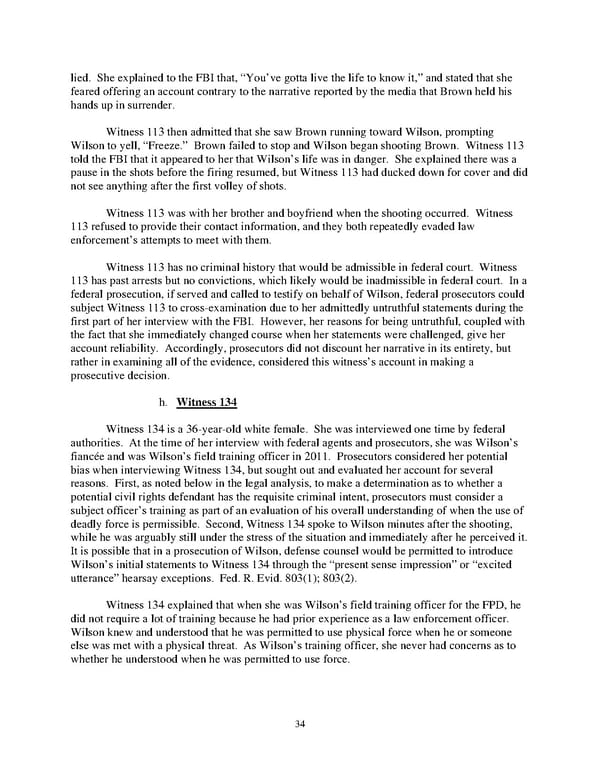lied. She explained to the FBI that, “You’ve gotta live the life to know it,” and stated that she feared offering an account contrary to the narrative reported by the media that Brown held his hands up in surrender. Witness 113 then admitted that she saw Brown running toward Wilson, prompting Wilson to yell, “Freeze.” Brown failed to stop and Wilson began shooting Brown. Witness 113 told the FBI that it appeared to her that Wilson’s life was in danger. She explained there was a pause in the shots before the firing resumed, but Witness 113 had ducked down for cover and did not see anything after the first volley of shots. Witness 113 was with her brother and boyfriend when the shooting occurred. Witness 113 refused to provide their contact information, and they both repeatedly evaded law enforcement’s attempts to meet with them. Witness 113 has no criminal history that would be admissible in federal court. Witness 113 has past arrests but no convictions, which likely would be inadmissible in federal court. In a federal prosecution, if served and called to testify on behalf of Wilson, federal prosecutors could subject Witness 113 to crossexamination due to her admittedly untruthful statements during the first part of her interview with the FBI. However, her reasons for being untruthful, coupled with the fact that she immediately changed course when her statements were challenged, give her account reliability. Accordingly, prosecutors did not discount her narrative in its entirety, but rather in examining all of the evidence, considered this witness’s account in making a prosecutive decision. h. Witness 134 Witness 134 is a 36yearold white female. She was interviewed one time by federal authorities. At the time of her interview with federal agents and prosecutors, she was Wilson’s fiancée and was Wilson’s field training officer in 2011. Prosecutors considered her potential bias when interviewing Witness 134, but sought out and evaluated her account for several reasons. First, as noted below in the legal analysis, to make a determination as to whether a potential civil rights defendant has the requisite criminal intent, prosecutors must consider a subject officer’s training as part of an evaluation of his overall understanding of when the use of deadly force is permissible. Second, Witness 134 spoke to Wilson minutes after the shooting, while he was arguably still under the stress of the situation and immediately after he perceived it. It is possible that in a prosecution of Wilson, defense counsel would be permitted to introduce Wilson’s initial statements to Witness 134 through the “present sense impression” or “excited utterance” hearsay exceptions. Fed. R. Evid. 803(1); 803(2). Witness 134 explained that when she was Wilson’s field training officer for the FPD, he did not require a lot of training because he had prior experience as a law enforcement officer. Wilson knew and understood that he was permitted to use physical force when he or someone else was met with a physical threat. As Wilson’s training officer, she never had concerns as to whether he understood when he was permitted to use force. 34
 DOJ Report on Shooting of Michael Brown Page 33 Page 35
DOJ Report on Shooting of Michael Brown Page 33 Page 35